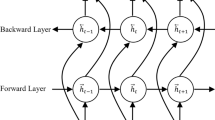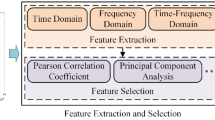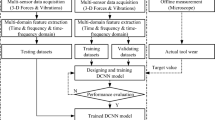Abstract
A major problem in the high-speed cutting process of machine tools is tool wear. Tool wear directly affects the surface quality and machining accuracy of the workpiece. However, the limits of fusing multiple sensing signals to indirectly monitor tool wear are rarely concerned in real manufacturing environments. In this paper, a tool wear identification method based on a single sensor signal is proposed. To solve the limits of less obtained information and poor anti-interference ability of single sensor, multi-domain feature fusion strategy is established. By establishing a hybrid model of deep convolutional neural network and stacked long short-term memory network, the complex mapping relationship between fusion features and tool wear is constructed. Specifically, the spatial features of the input data set are extracted by the convolution kernel of the deep convolutional neural network. Then, a stacked double-layer long short-term memory neural network is established to capture sequence features with long-term dependence, thereby identifying tool wear. Finally, the superiority of the developed method is verified by tool wear experiments. The results show that the method can be effectively applied to tool wear identification from single sensor signals, and the mean RMSE and MAE of the identification results are 9.43 and 7.15, respectively. Compared with four other traditional multiple regression methods, RMSE and MAE are reduced by 73.0% and 78.7% on average. This study provides a reference value for the industrial implementation of tool wear monitoring system.













Similar content being viewed by others
Data availability
All data generated or analyzed during this study are included in this published article.
References
Kusiak A (2018) Smart manufacturing. Int J Prod Res 56:508–517. https://doi.org/10.1080/00207543.2017.1351644
Ghobakhloo M (2018) The future of manufacturing industry: a strategic roadmap toward Industry 4.0. J Manuf Technol Manag 29:910–936. https://doi.org/10.1108/JMTM-02-2018-0057
Mia M, Królczyk G, Maruda R, Wojciechowski S (2019) Intelligent optimization of hard-turning parameters using evolutionary algorithms for smart manufacturing. Materials (Basel) 16. https://doi.org/10.3390/ma12060879
Khanna N, Airao J, Nirala CK, Krolczyk GM (2022) Novel sustainable cryo-lubrication strategies for reducing tool wear during ultrasonic-assisted turning of Inconel 718. Tribol Int 174:107728. https://doi.org/10.1016/j.triboint.2022.107728
Elsheikh A, Yacout S, Ouali MS (2019) Bidirectional handshaking LSTM for remaining useful life prediction. Neurocomputing 323:148–156. https://doi.org/10.1016/j.neucom.2018.09.076
Kuntoğlu M, Sağlam H (2019) Investigation of progressive tool wear for determining of optimized machining parameters in turning. Measurement 140:427–436. https://doi.org/10.1016/j.measurement.2019.04.022
Wang C, Bao Z, Zhang P et al (2019) Tool wear evaluation under minimum quantity lubrication by clustering energy of acoustic emission burst signals. Measurement 138:256–265. https://doi.org/10.1016/j.measurement.2019.02.004
Antić A, Popović B, Krstanović L et al (2018) Novel texture-based descriptors for tool wear condition monitoring. Mech Syst Signal Process 98:1–15. https://doi.org/10.1016/j.ymssp.2017.04.030
Guo H, Zhang Y, Zhu K (2022) Interpretable deep learning approach for tool wear monitoring in high-speed milling. Comput Ind 138:103638. https://doi.org/10.1016/j.compind.2022.103638
Kurada S, Bradley C (1997) A machine vision system for tool wear assessment. Tribol Int 30:295–304. https://doi.org/10.1016/S0301-679X(96)00058-8
García-Ordás MT, Alegre-Gutiérrez E, González-Castro V, Alaiz-Rodríguez R (2018) Combining shape and contour features to improve tool wear monitoring in milling processes. Int J Prod Res 56:3901–3913. https://doi.org/10.1080/00207543.2018.1435919
Wang J, Xie J, Zhao R et al (2017) Multisensory fusion based virtual tool wear sensing for ubiquitous manufacturing. Robot Comput Integr Manuf 45:47–58. https://doi.org/10.1016/j.rcim.2016.05.010
Salgado DR, Alonso FJ (2007) An approach based on current and sound signals for in-process tool wear monitoring. Int J Mach Tools Manuf 47:2140–2152. https://doi.org/10.1016/j.ijmachtools.2007.04.013
Liu C, Wang GF, Li ZM (2015) Incremental learning for online tool condition monitoring using Ellipsoid ARTMAP network model. Appl Soft Comput J 35:186–198. https://doi.org/10.1016/j.asoc.2015.06.023
Kong D, Chen Y, Li N, Tan S (2017) Tool wear monitoring based on kernel principal component analysis and v-support vector regression. Int J Adv Manuf Technol 89:175–190. https://doi.org/10.1007/s00170-016-9070-x
Li G, Wang Y, Wang J et al (2021) Tool wear prediction based on multidomain feature fusion by attention-based depth-wise separable convolutional neural network in manufacturing. Int J Adv Manuf Technol. https://doi.org/10.1007/s00170-021-08119-7
Duro JA, Padget JA, Bowen CR et al (2016) Multi-sensor data fusion framework for CNC machining monitoring. Mech Syst Signal Process 66–67:505–520. https://doi.org/10.1016/j.ymssp.2015.04.019
Li W, Liu T (2019) Time varying and condition adaptive hidden Markov model for tool wear state estimation and remaining useful life prediction in micro-milling. Mech Syst Signal Process 131:689–702. https://doi.org/10.1016/j.ymssp.2019.06.021
Wu D, Jennings C, Terpenny J et al (2018) Cloud-based parallel machine learning for tool wear prediction. J Manuf Sci Eng Trans ASME 140:1–10. https://doi.org/10.1115/1.4038002
Zhu K, Wong YS, Hong GS (2009) Multi-category micro-milling tool wear monitoring with continuous hidden Markov models. Mech Syst Signal Process 23:547–560. https://doi.org/10.1016/j.ymssp.2008.04.010
Javed K, Gouriveau R, Li X, Zerhouni N (2018) Tool wear monitoring and prognostics challenges: a comparison of connectionist methods toward an adaptive ensemble model. J Intell Manuf 29:1873–1890. https://doi.org/10.1007/s10845-016-1221-2
Cheng M, Jiao L, Yan P et al (2022) Intelligent tool wear monitoring and multi-step prediction based on deep learning model. J Manuf Syst 62:286–300. https://doi.org/10.1016/j.jmsy.2021.12.002
Cai W, Zhang W, Hu X, Liu Y (2020) A hybrid information model based on long short-term memory network for tool condition monitoring. J Intell Manuf 31:1497–1510. https://doi.org/10.1007/s10845-019-01526-4
Shah M, Vakharia V, Chaudhari R et al (2022) Tool wear prediction in face milling of stainless steel using singular generative adversarial network and LSTM deep learning models. Int J Adv Manuf Technol 121:723–736. https://doi.org/10.1007/s00170-022-09356-0
Li Z, Liu X, Incecik A et al (2022) A novel ensemble deep learning model for cutting tool wear monitoring using audio sensors. J Manuf Process 79:233–249. https://doi.org/10.1016/j.jmapro.2022.04.066
Huang Z, Zhu J, Lei J et al (2020) Tool wear predicting based on multi - domain feature fusion by deep convolutional neural network in milling operations. J Intell Manuf 31:953–966. https://doi.org/10.1007/s10845-019-01488-7
Ghosh N, Ravi YB, Patra A et al (2007) Estimation of tool wear during CNC milling using neural network-based sensor fusion. Mech Syst Signal Process 21:466–479. https://doi.org/10.1016/j.ymssp.2005.10.010
Bazi R, Benkedjouh T, Habbouche H et al (2022) A hybrid CNN-BiLSTM approach-based variational mode decomposition for tool wear monitoring. Int J Adv Manuf Technol 119:3803–3817. https://doi.org/10.1007/s00170-021-08448-7
Duan J, Duan J, Zhou H et al (2021) Multi-frequency-band deep CNN model for tool wear prediction. Meas Sci Technol 32. https://doi.org/10.1088/1361-6501/abb7a0
Chen Q, Xie Q, Yuan Q et al (2019) Research on a real-time monitoring method for the wear state of a tool based on a convolutional bidirectional LSTM model. Symmetry (Basel) 11. https://doi.org/10.3390/sym11101233
An Q, Tao Z, Xu X et al (2020) A data-driven model for milling tool remaining useful life prediction with convolutional and stacked LSTM network. Measurement 154:107461. https://doi.org/10.1016/j.measurement.2019.107461
Kong D, Chen Y, Li N et al (2019) Relevance vector machine for tool wear prediction. Mech Syst Signal Process 127:573–594. https://doi.org/10.1016/j.ymssp.2019.03.023
Cuka B, Kim DW (2017) Fuzzy logic based tool condition monitoring for end-milling. Robot Comput Integr Manuf 47:22–36. https://doi.org/10.1016/j.rcim.2016.12.009
Chen B, Chen X, Li B et al (2011) Reliability estimation for cutting tools based on logistic regression model using vibration signals. Mech Syst Signal Process 25:2526–2537. https://doi.org/10.1016/j.ymssp.2011.03.001
Wang GF, Yang YW, Zhang YC, Xie QL (2014) Vibration sensor based tool condition monitoring using ν support vector machine and locality preserving projection. Sensors Actuators A Phys 209:24–32. https://doi.org/10.1016/j.sna.2014.01.004
Benkedjouh T, Medjaher K, Zerhouni N, Rechak S (2015) Health assessment and life prediction of cutting tools based on support vector regression. J Intell Manuf 26:213–223. https://doi.org/10.1007/s10845-013-0774-6
Morgan J, O’Donnell GE (2018) Cyber physical process monitoring systems. J Intell Manuf 29:1317–1328. https://doi.org/10.1007/s10845-015-1180-z
Wang J, Yan J, Li C et al (2019) Deep heterogeneous GRU model for predictive analytics in smart manufacturing: Application to tool wear prediction. Comput Ind 111:1–14. https://doi.org/10.1016/j.compind.2019.06.001
Funding
The authors are grateful to the financial supports of the National Natural Science Foundation of China (No. 52275445) and the Shandong Provincial Key Research and Development Program (Nos. 2020CXGC010204, 2021JMRH0301).
Author information
Authors and Affiliations
Contributions
All authors contributed to this research. Yezhen Peng is responsible for the design of the algorithm, analysis and validation of the experimental data and writing of the manuscript. Qinghua Song and Zhanqiang Liu are responsible for the discussion of ideas and methods, review of the manuscript, and financial support. Runqiong Wang is responsible for signal pre-processing and algorithm review. Zhaojun Liu is responsible for the editing and review of the paper.
Corresponding author
Ethics declarations
Ethical approval
All authors declare that there are no ethical implications of this study.
Consent to participate
All authors agree to submit the manuscript to IJAMT.
Consent to publish
All authors agree to publish this study. There are no potential copyright/plagiarism issues involved in this study.
Conflict of interest
The authors declare no competing interests.
Additional information
Publisher's note
Springer Nature remains neutral with regard to jurisdictional claims in published maps and institutional affiliations.
Rights and permissions
Springer Nature or its licensor (e.g. a society or other partner) holds exclusive rights to this article under a publishing agreement with the author(s) or other rightsholder(s); author self-archiving of the accepted manuscript version of this article is solely governed by the terms of such publishing agreement and applicable law.
About this article
Cite this article
Peng, Y., Song, Q., Wang, R. et al. Intelligent recognition of tool wear in milling based on a single sensor signal. Int J Adv Manuf Technol 124, 1077–1093 (2023). https://doi.org/10.1007/s00170-022-10404-y
Received:
Accepted:
Published:
Issue Date:
DOI: https://doi.org/10.1007/s00170-022-10404-y




